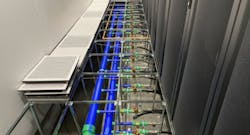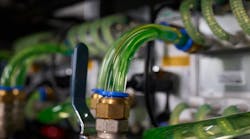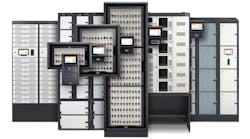From Design to Deployment: How Liquid Cooling Services Enable AI at Scale.
As AI workloads continue to drive unprecedented power densities in data centers, operators are rapidly approaching the limits of traditional air cooling. Liquid cooling is no longer a niche solution, it has become central to modern thermal strategy. But deploying it successfully requires more than hardware.
In this Q&A, Paul Lee, Director of Professional Services at CoolIT, shares insights into how liquid cooling services enable scalable, reliable and efficient adoption of liquid cooling across all data center environments and at any size.
Data Center Frontier:
Paul, the industry knows that AI workloads are pushing thermal limits, why is liquid cooling a critical part of modern data center strategy?
Paul Lee:
AI workloads are reaching the practical limits of air cooling. Racks that used to run at 25 to 30 kilowatts now exceed 100 kilowatts. At that density, air cooling just isn’t viable. Liquid cooling offers a much more efficient way to manage heat in these environments.
But successful adoption requires more than just installing liquid cooling hardware. You need expertise in system design, deployment and maintenance. Engaging professional services early helps reduce the risk of downtime and costly setbacks during implementation.
DCF:
You just mentioned professional services. Why are they such an important part of making that transition to liquid cooling successful?
Lee:
Air cooling is well understood. Liquid cooling introduces new planning and integration requirements that most operators haven’t dealt with before. Professional services help minimize risk, especially in AI and HPC environments where power densities are high.
Our team helps customers navigate that complexity. We provide the expertise needed to ensure the system is designed correctly, integrated properly and maintained effectively.
DCF:
So, when operators come to you, where do they usually need the most support?
Lee:
Operators tend to lean on our team at three key phases:
- Design. This is a key phase. We start with site-specific collaboration, assessing the facility, finalizing CDU selection and sizing, and designing the technology cooling system (TCS) loops. Early planning ensures scalability, reliability and serviceability. Even in existing facilities, early involvement helps identify issues and optimize layout.
- Deployment. We prefabricate Technology Cooling Loops (TCL) off-site to streamline construction. Our skilled personnel handle installation, commissioning and handover. That keeps projects on schedule and reduces risk.
- Maintenance. Liquid cooling systems are fundamentally different from air-cooled ones. We support ongoing monitoring, preventive maintenance, staff training and upgrades to keep systems running efficiently and evolving with changing workloads.
DCF:
And what happens when professional services aren’t involved early on? What kinds of mistakes do you see operators run into?
Lee:
The biggest mistake we see operators make is underestimating the scope of change. In brownfield conversions especially, operators sometimes assume liquid cooling can be added without major adjustments. But factors like thermal design loads, pump sizing and distribution piping all need to be considered.
For example, an existing chilled-water loop designed for air handlers may not have the flow rates or supply temperatures needed for direct liquid cooling. We’ve also seen cases where operators underestimate the structural requirements for new CDUs or don’t leave enough space for service. These oversights can create operational inefficiencies or even reliability risks once the system is live.
DCF:
Every new technology shift comes with a learning curve. Where do you see professional services making the biggest difference in helping operators move confidently from air to liquid cooling?
Lee:
Training is a major one. Operators are experienced with air-cooled systems, but liquid cooling is new territory. We provide resources to help them transition and ensure consistency in service and support across global operations.
There are understandable misconceptions about liquid cooling. We educate teams on the precautions we take for redundancy, monitoring and proven deployment practices. We also clarify that it’s not just water; we use fluids like PG25 or LC25, and compatibility matters. It’s not plug-and-play yet, there are real considerations when mixing and matching components.
DCF:
Can you share a real-world example where professional services made a critical difference in a deployment?
Lee:
We worked with a hyperscaler where we discovered their flushing procedures weren’t adequate. Filters were clogging within minutes. That kind of oversight can make the system inoperable. If you catch it early, ideally before CDUs are brought online, you can move flushing out of the critical path and avoid damage. Our team helped them revise their process and by the next deployment, their procedures were top-tier.
That same project also highlights the value of prefabricated TCLs. We are able to assemble and flush loops off-site and bolt them together on-site. This eliminates the need for field welding, minimizing flushing requirements and reduces construction risk.
DCF:
You’ve been doing this for a long time. From your perspective, what really sets apart a strong professional services team from one that’s still finding its footing?
Lee:
Expertise. CoolIT has been doing liquid cooling for over 24 years and in data centers specifically for 13 of those years. We understand the full value chain from chip to CDU. Our team is specialized; everyone we send to site is a liquid cooling expert. That depth of knowledge and focus is what sets us apart.
Other companies have field services teams that cover a broad range of products. For us, this is our core business. That’s the feedback we get in the field, our people know what they’re doing and it shows.
DCF:
And finally, as AI continues to scale, what role do you see professional services playing in the years ahead?
Lee:
As rack densities increase, cooling complexity will rise. Professional services will become as critical as the hardware itself. Expertise in design-for-serviceability, rapid deployment and scalability will define successful rollouts.
A strong services partner simplifies complexity and helps operators scale faster while focusing on their core business. That’s going to be essential as AI infrastructure continues to evolve.
About the Author

Paul Lee
Paul Lee is Director of Professional Services at CoolIT Systems, where he leads the team responsible for solution design, field deployments, and operational support. His team partners with OEMs, hyperscalers, and service providers to ensure reliable execution and a seamless customer experience.
Paul champions a collaborative, cross-functional approach that connects Engineering, Product, Operations, and Quality teams to streamline service delivery and accelerate innovation. His leadership is grounded in practical, solution-oriented thinking that supports the evolving needs of advanced data center environments.
With over a decade of experience across engineering, operations, and service leadership, Paul has helped teams deliver reliable, scalable solutions in complex, high-performance settings with a focus on real-world results.



